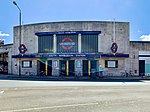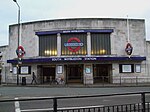St Winefride Church, South Wimbledon
1905 establishments in England20th-century Roman Catholic church buildings in the United KingdomChurches in the Diocese of SouthwarkFrederick Walters buildingsGrade II listed Roman Catholic churches in England ... and 4 more
Grade II listed churches in LondonRoman Catholic churches completed in 1905Roman Catholic churches in the London Borough of MertonRomanesque Revival church buildings in England

St Winefride Church is Roman Catholic Parish church in South Wimbledon in the London Borough of Merton. It was founded as a chapel of ease of Sacred Heart Church, Wimbledon by the Society of Jesus in 1905. It is Grade II listed building and was designed by Frederick Walters.
Excerpt from the Wikipedia article St Winefride Church, South Wimbledon (License: CC BY-SA 3.0, Authors, Images).St Winefride Church, South Wimbledon
Latimer Road, London South Wimbledon (London Borough of Merton)
Geographical coordinates (GPS) Address External links Nearby Places Show on map
Geographical coordinates (GPS)
| Latitude | Longitude |
|---|---|
| N 51.4195 ° | E -0.1937 ° |
Address
St Winefride's
Latimer Road 2
SW19 1EP London, South Wimbledon (London Borough of Merton)
England, United Kingdom
Open on Google Maps











